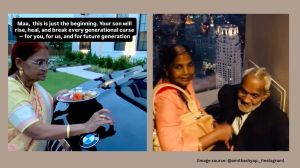From ‘Smitaben’s son’ to the buffalo called ‘Manthan’: A Gujarat village’s recollections of Shyam Benegal’s 1976 classic
In the 1970s, Dr Verghese Kurien, the man behind the success of Amul, approached filmmaker Shyam Benegal to make what went on to become a national award-winning cinema. Nearly half a century later, the memory of the film still lives on in the village.
 A black a white photo of Shyam Benegal in action during shooting of ‘Manthan’ in Sanganva village. (Special Arrangement)
A black a white photo of Shyam Benegal in action during shooting of ‘Manthan’ in Sanganva village. (Special Arrangement)“Aa Bhaglo, Smitaben no dikro, (Meet Bhaglo, son of Smita Patil)”. That’s how Bhagwanji Rakhaiya, 54, a contractor from Rajkot’s Sanganva village — where Shyam Benegal’s 1976 masterpiece Manthan was shot in the 1970s — has been introduced to anyone new for the last 50-odd years.
Bhagwanji played the part of Bhagla Bhagwan, the toddler-son of Smita Patil’s Bindu in the national award-winning movie, which recounts the tale of India’s ‘Milk Revolution’ but also with powerful undertones of caste and gender hierarchies in villages.
On December 24, Benegal, considered the father of India’s parallel cinema, breathed his last at the age of 90 in Mumbai’s Wockhardt Hospital. But for the village of Sanganva, Benegal’s legacy lives in every corner of the village – its walls, its houses, even its empty grounds where the crew of the movie, including big names such as Girish Karnad and Naseeruddin Shah, would play volleyball, and even in its caller tunes.
It was in this village of 1,500, located some 25 km from district headquarters of Rajkot, that the crew camped for 45 days as they completed what went on to become one of India’s most enduring ‘arthouse’ cinemas.
 Sanganva Sarpanch Kaushik Rakhaiya showing a house used during the shooting of the film ‘Manthan’ in the village | Photo credit: (Express photo: Chirag Chotaliya)
Sanganva Sarpanch Kaushik Rakhaiya showing a house used during the shooting of the film ‘Manthan’ in the village | Photo credit: (Express photo: Chirag Chotaliya)
Bhagwanji was only a toddler when he appeared in the movie. But he remembers what his father told him about the shoot. Now, he talks about the time when a cousin took him to a barber’s shop for a routine haircut.
“As soon as the film crew heard about this, they rushed to the barber’s and did not allow the haircut as that would have disturbed the uniformity of my look in the film,” he tells The Indian Express.
In another part of the village, 65-year-old Ambabhai Rakhaiya, whose house was used as Bindu’s home in the movie, talks fondly and proudly of the time that the crew shot the famous buffalo poisoning scene from the movie outside their house. The crew then gifted the buffalo to the family, who named it ‘Manthan’ and tended to it till its death.
“I observed a fast when Benegal died as a mark of respect. A great man who brought to films the issue of untouchability for the first time. Before that, nobody had done that,” Rakhaiya, a Dalit, says.
 From the shoot of the movie ‘Manthan’.(Photo: Special Arrangement)
From the shoot of the movie ‘Manthan’.(Photo: Special Arrangement)
According to Deputy Sarpanch Narendrasinh Jadeja, 68, the film’s lead, Girish Karnad, had taken a now run-down house of one of his relatives on lease during the shoot.
“Benegal lived in a house owned by Girivarsinh Jadeja, then the general manager of the Opera House in Mumbai,” he says. “Some crew members would play volleyball outside this house after the day’s shoot. I would also join them at times. Smita Patil had even got two lights installed there so that they could play even at night.”
But not everyone in the village was so accommodating of the crew’s demands. One of them was Punjabhai Rakhaiya, 72, whose house the crew sought for the shoot.
“There is a scene in the film where a locality has been set on fire. The film crew asked us to give houses of the Dalit locality for the scene. They also said that once the scene is over, the burnt houses would be built afresh and we would get new houses. But we were sceptical and didn’t agree. So, the film crew built similar houses and shot the scene there,” he said.
 Bhagwanji Rakhaiya (centre) and Punjabhai Rakhaiya (right) at Sanganva village. (Express photo: Chirag Chotaliya)
Bhagwanji Rakhaiya (centre) and Punjabhai Rakhaiya (right) at Sanganva village. (Express photo: Chirag Chotaliya)
According to the village residents, the movie is now an intrinsic part of the village. Several villagers still have the iconic song ‘Mero Gaam Katha Paare’ as their caller tune, Chandrasinh Jadeja, 61, a retired government employee, says.
But it’s not only the older generation that connects with the movie. Chhaya Rakhaiya, 22, grew up listening to tales of the movie shoot. “I may not have witnessed the film shooting but I have heard a lot. Not just about the shooting but also about the film and its messaging,” Rakhaiya, who’s now pursuing her Masters in Social Work, says. “Being a student of social work, I can now relate to it even more.”
It was Dr Verghese Kurien, the man behind the success of India’s first farmers’ integrated dairy cooperative — the Anand Milk Union Limited (AMUL) — and the father of India’s ‘White Revolution’, who convinced Benegal to make the movie.
This May, the movie got a new lease of life when it was restored in the 4K version and screened at the 77th edition of the Cannes Film Festival.
 A view of the village of Sanganva village. (Express photo: Chirag Chotaliya)
A view of the village of Sanganva village. (Express photo: Chirag Chotaliya)
“Sanganva may have been chosen as it was the most rustic location,” says Kurien’s 66-year-old daughter Nirmala. “I assume that this village would have allowed the makers to depict the olden times before my father came to Gujarat, since the villages under Amul (Kaira cooperative) would be developed by the time the film came about.”
She also recounts how her disciplinarian father approached a rather reluctant Benegal to make the movie.
“He told my father, ‘Who will see your movie?’. My dad said, ‘You don’t worry about that’. Then he asked my father how they’ll get Rs 10 lakh for the movie. My father went into the board meeting and asked if he could collect Rs 2 from each dairy farmer. They all agreed and thus, it became India’s first crowd-funded film,” she says.
Much has changed since the movie was made in 1975. The village’s then dusty roads and roof tiles have now given way to paved roads and houses with RCC ceilings. What has not changed, however, is the village’s recollections of the movie.
 A gate of Sanganva village, Rajkot. (Express photo: Chirag Chotaliya)
A gate of Sanganva village, Rajkot. (Express photo: Chirag Chotaliya)
“Benegal and the film crew gave free passes to the village residents and even arranged for buses to ferry them to Dharam Cinema in Rajkot, where the film was released,” Madhavsinh Jadeja, whose name appears in the opening credits along with several others of the village, says.
For Ambabhai, the film is even bigger than a blockbuster like Sholay (1975). “I’m proud of the fact that the movie was shot in my village and we were part of it,” he adds.
With inputs from Aditi Raja in Vadodara






- 01
- 02
- 03
- 04
- 05
























